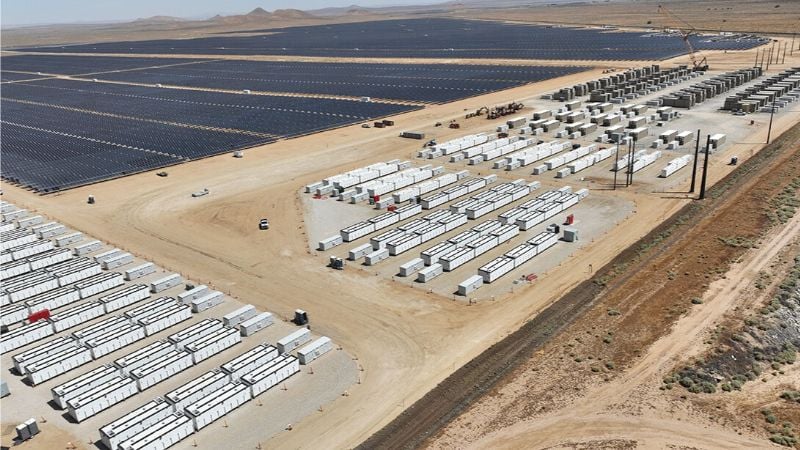Mojave Desert Welcomes Massive Solar-Plus-Storage Park at CA Air Force Base
A 4,600-acre solar-plus-storage facility sharing land with the Air Force has started operating in Southern California’s Mojave Desert.
Southern California’s desert-side Edwards Air Force Base is now home to the highest-capacity solar and battery installation in the United States. The site covers 4,600 acres and has 875 MW of solar photovoltaic (PV) panels and 3.2 GWh of battery storage containers.
America’s largest solar-plus-battery storage project was completed in early 2024. Image used courtesy of Mortenson
The $2 billion Edwards & Sanborn Solar and Energy Storage project is among the nation’s largest solar-plus-storage sites. Linking 1.3 GW of interconnection capacity to the California Independent System Operator (CAISO) grid, the installation is expected to serve 238,000 homes.
The project includes nearly 2 million solar modules, about half on property leased by the Air Force and the rest on adjacent private land. The site on the western end of the Mojave Desert is one of the nation’s sunniest locations. According to National Renewable Energy Laboratory data, the area provides an annual average daily solar resource of 5.75 kWh per square meter.
New York-based renewable energy firm Terra-Gen developed the project and commissioned Minnesota builder Mortenson as the engineering, procurement, and construction contractor. Mortenson’s scope covered both solar and energy storage components. It also built new cables to support grid connections, including nearly 100 miles of medium-voltage wires and more than 360 miles of direct current wires.
The National Aeronautics and Space Administration’s Landsat 9 satellite captured this image of the Edwards & Sanborn project in January 2024. Image used courtesy of the NASA Earth Observatory
Terra-Gen secured long-term offtake agreements with utilities Southern California Edison, Pacific Gas & Electric Co., and the Clean Power Alliance, alongside the City of San Jose and Starbucks. The latter customer is particularly noteworthy: the coffee giant was the first corporation to execute a virtual power purchase agreement for utility-scale storage. In 2020, Starbucks agreed to procure 24 MW of solar and 5.5 MW of battery storage capacity from the Edwards & Sanborn project.
The project’s 875 MW of solar capacity beats the largest PV installations in the U.S., including Copper Mountain Solar in Nevada (over 800 MW across five phases), Mount Signal Solar (800 MW across three solar farms and millions of panels), and Solar Star (586 MW of co-located projects with 1.7 million modules).
With over 3 GWh of storage, it’s the nation’s largest battery project, surpassing Moss Landing in California (750 MW/3 GWh) and Florida’s Manatee Battery Energy Storage Center (409 MW/900 MWh).
Battery and Solar Tech
Several suppliers contributed technology to the project. Its 120,720 lithium-ion batteries came from South Korean tech giants LG Chem and Samsung, as well as Chinese manufacturer BYD.
The Edwards & Sanborn solar-plus-storage project. Image used courtesy of Terra-Gen
The more than 1.9 million solar modules were supplied by First Solar, an Arizona-based company producing advanced thin-film cadmium telluride PV modules as a high-performance alternative to traditional crystalline silicon technology.
Terra-Gen didn’t disclose the specific product series of the modules used in the project. However, Terra-Gen Construction Manager Jonathan Garcia stated in a promotional video that the modules vary from 445 W to 460 W, consistent with First Solar’s Series 6 line, offering 430–480 W units with more than 18% efficiency.
Solar and Battery Storage Capacity Growth
The solar-plus-storage project interconnects with CAISO, the grid operator serving 80% of California and part of Nevada. Battery storage is the fastest-growing resource in CAISO’s market, accounting for 7.6% of its nameplate capacity. The operator already leads the nation in battery storage, with 6.3 GW/24.5 MWh installed — nearly half of all U.S. capacity as of mid-2023, according to S&P Global Commodity Insights.
The operator’s share of hybrid solar-plus-storage projects is growing. In a report last year, the operator said it had 2.5 GW of active hybrid renewable-plus-storage capacity, including generation components. Most batteries in its network have a four-hour duration.
Active battery capacity in the CAISO region. Image used courtesy of CAISO
Solar PV and battery storage resources are charting substantial growth nationwide this year. The U.S. Energy Information Administration anticipates that both will claim 81% of utility-scale generating capacity added in 2024. That includes 36.4 GW of solar, nearly double last year’s 18.4 GW of new capacity. Battery storage is projected to break records, totaling 14.3 GW, again almost double the 6.4 GW installed in 2023.










